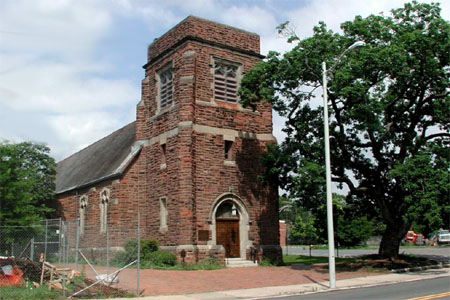| |
 |
 |
 |
| Comment on this report, or find other reports. |
 |
| Our Mystery Worshippers are volunteers who warm church pews for us around the world. If you'd like to become a Mystery Worshipper, start here. |
 |
| Find out how to reproduce this report in your church magazine or website. |
|
|
| 3204: St Philip's, Durham, North Carolina, USA |
 |
 |
 |
Mystery Worshipper: Polypheme.
The church: St Philip's, Durham, North Carolina, USA.
Denomination: The Episcopal Church, Diocese of North Carolina.
The building: Dating from 1907, it is the work of the early 20th century American architect Ralph Adams Cram, noted for his hundreds of Gothic Revival churches, public buildings, schools and private residences. It is a very successful building in the style of a village parish church, with west tower, aisle on the north side only, separate chancel, etc. The churchyard is completely enclosed, but there is a strong feeling of openness and welcome.
The church: St Philip's is Durham's downtown parish, drawing its very diverse congregation from the whole city. It is aggressively gender-neutral, color-blind, and LGBT friendly. Quoting from their website: "We are a diverse family ... but each of us has unique gifts and roles to play in healing a hurting world." There are a number of social activities, including a Wednesday community dinner, a seniors lunch, and a men's group called Beer and Bull, (again quoting from their website) "where men talk about faith, politics, sports, and just about anything else." Other groups and community outreaches are well described on their website. There are three Sunday eucharists – said, sung, and with choir – and a weekday eucharist on Wednesdays, with a healing service on the first Wednesday of each month. Although not listed on their website, they have recently added a Sunday evening said eucharist, which is what I attended.
The neighborhood: Durham was originally a thriving agricultural center thanks primarily to tobacco. But tobacco is long gone from the region's economy, and today Durham is known for culture and sports. It is the home of Duke University, a private school that enjoys a reputation as an academic and research powerhouse. The university and Duke Medical Center are the area's major employers. Politically, Durham is a staunchly Democratic enclave in a solidly Republican state. During the 1950s, Durham figured prominently in the civil rights movement, and is widely regarded to be the site of the first sit-in ever to be organized. The church's location adjoining Urban Ministries of Durham is one of its blessings.
The cast: The Revd M. Jonah Kendall, rector, was the celebrant.
The date & time: Sunday, July 16, 2017, 5.30pm.
What was the name of the service?
Holy Eucharist.
How full was the building?
We were 15 people in a side chapel.
Did anyone welcome you personally?
The verger, Mick Capon, served as a very effective greeter, distributing the leaflet for the simple service.
Was your pew comfortable?
Oak pew. Very comfortable for the 26 minutes the service lasted.
How would you describe the pre-service
atmosphere?
Quiet and reverential, punctuated by the joyful chatter of a toddler.
What were the exact opening words of the
service?
"Blessed be God: Father, Son, and Holy Spirit."
What books did the congregation use during the
service?
Four-page leaflet; 1979 Book of Common Prayer.
What musical instruments were played?
No music.
Did anything distract you?
When I arrived and saw no one else there, I wondered if I would be the only person in attendance!
Was the worship stiff-upper-lip, happy clappy, or
what?
Careful Prayer Book service, appropriately abbreviated to the max.
Exactly how long was the sermon?
4 minutes.
On a scale of 1-10, how good was the preacher?
10 – The rector's exposition was sound, but sometimes he seemed to be directing his voice at the empty air rather than to the 15 of us who were listening.
In a nutshell, what was the sermon
about?
The rector took as his text the day's gospel lesson, the parable of the sower. This is a handy parable because Jesus presents it and then explains it. But anyone living in an agrarian society would immediately spot a serious fallacy: no self-respecting farmer would sow hard-won seed on the path or on rocky ground or in weeds. But God, ever generous, scatters his seed everywhere.
Which part of the service was like being in
heaven?
The sermon was clever, passionate, uplifting!
And which part was like being in... er... the other place?
The way the preacher seemed to preach to the empty air.
What happened when you hung around after the service looking lost?
There was no reception.
How would you describe the after-service
coffee?
No refreshments.
How would you feel about making this church your regular (where 10 = ecstatic, 0 = terminal)?
10 – I have experienced the radical wonder here before. If I lived in Durham there would be no question – this would be my church.
Did the service make you feel glad to be a
Christian?
Yes, and sent me out wanting to be a better Christian.
What one thing will you remember about all this in seven days' time?
The strong sense of community among the 15 of us, even though three of us were visitors from out of town. |
|
|
 |
 |
 |
| We rely on voluntary donations to stay online. If you're a regular visitor to Ship of Fools, please consider supporting us. |
 |
 |
 |
| The Mystery Pilgrim |
 |
| One of our most seasoned reporters makes the Camino pilgrimage to Santiago de Compostela in Spain. Read here. |
 |
 |
 |
| London churches |
 |
| Read reports from 70 London churches, visited by a small army of Mystery Worshippers on one single Sunday. Read here. |
| |
|
|
|
|


